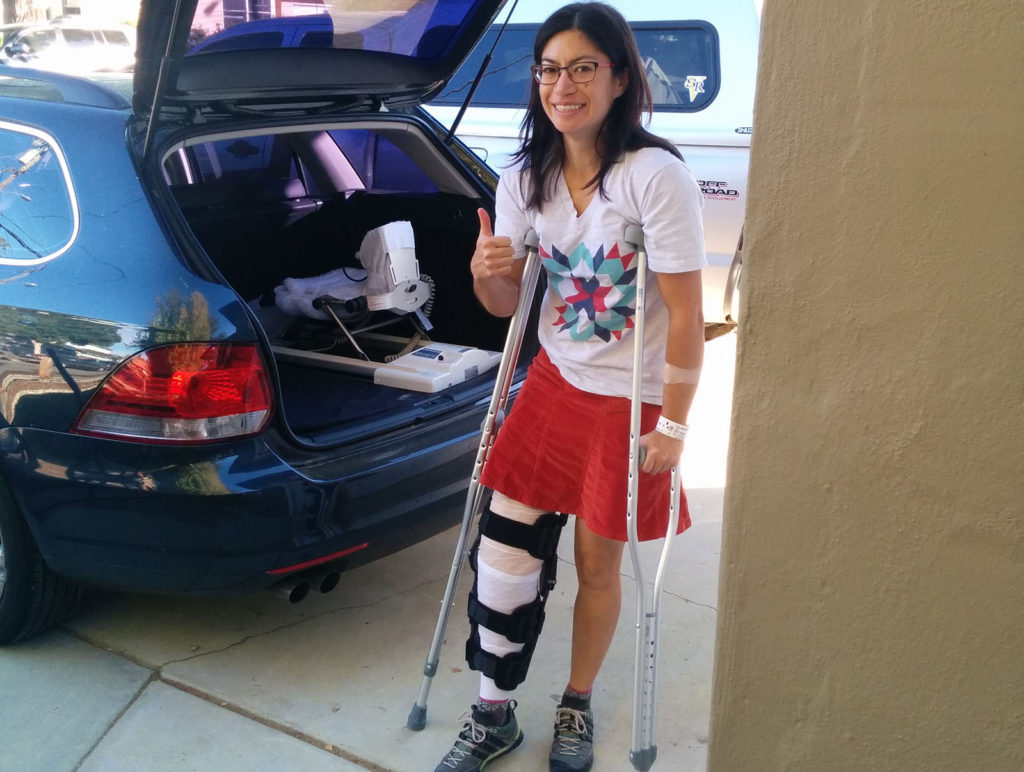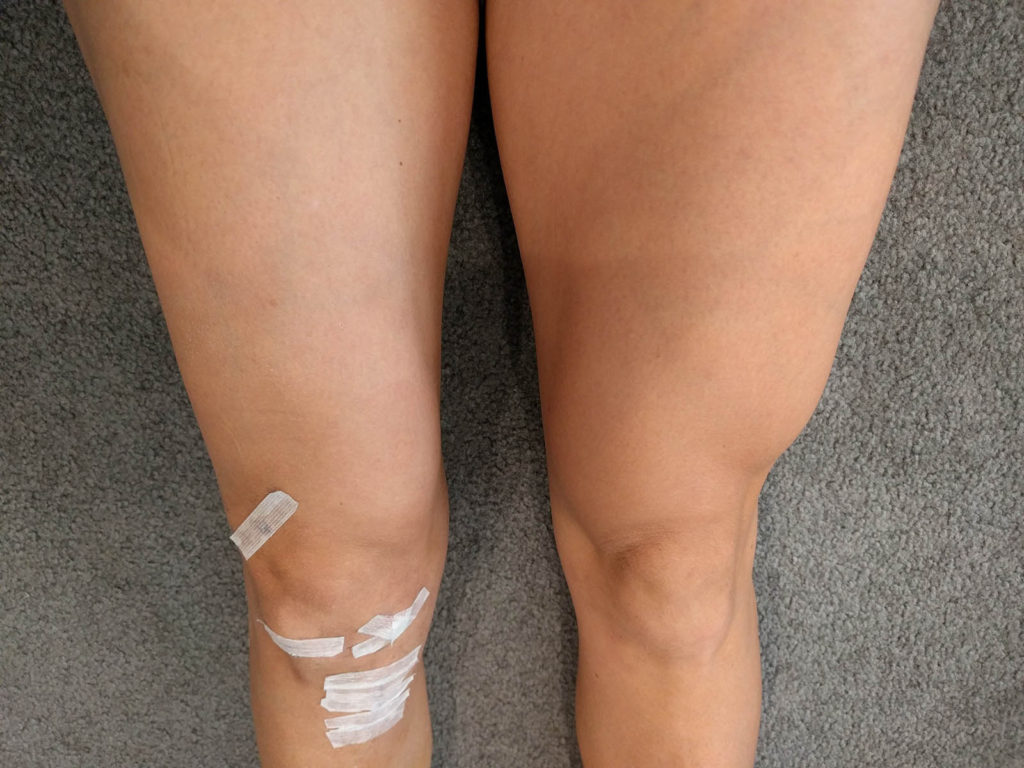What you’ll learn
This article is Part 2 of the ACL Reconstruction Surgery series, especially for fit, active folks and rock climbers. This covers logistics and planning that will make your life much easier for your ACL surgery and first week.

Work and Home Care
After ACL surgery, I took off 2 weeks from work. I was on crutches for 2 weeks after surgery; even in the 3rd week, standing or being on my feet for too long made my leg swell and heat up, and just going to the grocery store was exhausting.
I had my husband at home with me the whole time–lucky he works remotely from home. I highly recommend you have someone with you 24/7 for the first couple days. You’ll be out of it from drugs and antibiotics, you’ll be in some pain, and there’s no great way to change the ice machine every 4 hours when you’re on crutches.
Ice Machine
The best piece of advice I got was to buy an electric ice machine pump. It wasn’t covered under insurance and runs ~$150-$200, but it’s a huge lifesaver in the first 2 weeks, when it’s critical to get full range of motion back. You wrap the sleeve around your knee, fill the cooler with ice and water, plug it in, and it starts pumping water through the sleeve, circulating cold water.
The entire cooler of ice went warm in 4 hours. I had it running 24/7 for the first 7 days. Get the ice machine. There are theories about limiting icing after an injury, as blood helps heal, but ACL surgery is very traumatic and this falls outside the leave-it-alone camp. It’ll speed up your recovery.
CPM Machine
Some surgeons recommend a continuous passive motion (CPM) machine and some don’t. I had it both times and insurance covered the rental thru the hospital. You strap your leg into the machine and program how many degrees from 90 degrees that it bends your leg back and forth. I was strapped into this dang bugger for 6 hrs/day the 1st week, in 2hr stints.

Research is inconclusive on whether CPM machines have positive post-surgical benefit. Personally, it made my knee feel more lubricated. I’d wake up with a stiffer knee than I went to sleep with and by the end of the 6 hrs in the CPM, I increased range of motion by 20 degrees total. Getting your knee to full extension as soon as possible is the most important–without full extension, you won’t be able to walk correctly, which will lead to other issues.
While 6 hrs/day doesn’t sound too bad, it’s actually hard if you’re not used to couch surfing for hours a day. Find friends with books and Netflix. My full list of actually-worth-it-to-read fitness and heath books is here.
The Surgery
Not much to say here other than you count backwards from 10, black out, and wake up to a nice nurse in the post-op room. ?
Pain
My 1st surgery with a cadaver graft, I had basically no pain whatsoever, and I was off pain meds in 3 days. There’s essentially only one 1.25″ incision with some pinholes. They inject your knee with a local anesthetic on the operating table before suturing you up, and the incision cuts through a nerve right below your knee. You regain feeling in a few months, which is trippy since you touch your scar and you have feeling on the other side of your leg.
My 2nd surgery with my hamstring graft was fairly painful in my hamstring with no pain in my knee, again. The first 2 days I didn’t want to sit on the edge of a hard chair…like the toilet…since it put pressure on the back of my leg. I kept a small stool in front of the toilet to prop my leg up on so it was extended and all the weight on my heel. I was off pain meds by day 6.
Crutches
My surgeon’s protocol called for no weight on my operated leg for week 1 and toe-downs (20% weight) for week 2, and then full weight as pain allowed for week 3. I essentially went from crutches to walking on day 15.
Crutches are clunky, and I recommend you stake out your home pre-surgery. Considerations: Use a water bottle, don’t drink from water glasses. Figure out how you’re getting your water bottle from the couch to the kitchen to refill and back using crutches (carry a small bag everywhere). Figure out how you get your food from the fridge/cupboard to the counter to the microwave/stove to the table. Figure out how you’re going to get the mail. Figure out how you’re going to make coffee and get creamer from the fridge into your coffee. Buy snacks and food that are easy to prepare. Stash snacks at your couch. Etc.
Brace
My surgeon’s protocol called for wearing a full-leg brace 24/7, locked at 10 degrees, while I was on crutches. Literally, every second you’re not in the CPM machine, that brace is on.

I’ve heard other surgeons go to the extent of not requiring a post-op brace. Trust me, you’ll feel like you want a steel pipe surrounding your post-op leg. For the next 3 months you’ll be watching your every step, everyone’s step around you, and scare yourself at least 5 times that you’ve ruptured your graft (joke, but you will have paranoid oh shit moments).
In all seriousness, when you’re on meds, getting off the couch or out of bed from a sleep won’t be your most graceful moments. Not to mention showering on a slick surface. My surgeon had me sleep with the brace through month 1.
Showering
For the first 2 weeks before your stitches are removed, you’re not supposed to get your sutures wet. If you’re thinking you’ll dirtbag it and wash up a couple times: showering was the highlight of my day to feel normal in an otherwise couch-filled existence.
My system included putting my leg in a 30gal black trash bag and knotting a rubber band on the top (sacrifice a colored exercise band). If it leaks a little, wrap a hand towel at the top rubber band underneath the trash bag. Another method that worked fairly well was wrapping my leg with Press ‘n Seal/Saran plastic wrap–wrap from bottom up. Secure the ends with a rubber band.

Milestones: Week 1
- Leg to full extension: ice and CPM machine
- Prevent muscle atrophy: squeeze muscles while laying down
- Relax, reduce stress, read, watch Netflix
- Positive attitude!
Physical Therapy
Atrophy is serious in 2 weeks of not using your muscles, plus the surgery is more trauma, so your body is going to shut it down to protect it. I lost 1.25″ of circumference in 2 weeks in my muscle.
One of the best things you can do in the first 2 weeks is to contract and relax your leg muscles: shin, calf, quad, hamstring. If you’re using a cadaver graft, you should have no problem. If you’re using your own tissue, contract whatever isn’t painful. Just activating your muscles will do wonders to prevent atrophy.

I didn’t go to PT until week 2, but discussed week 1 with my therapist beforehand. Contract and relax and work on leg extension–don’t let your knee get stiff.
Working Out
You’re an active person, you’re motivated, and super gung-ho about not losing strength. Honestly, in the 1st week, I didn’t want to work out at all. I was exhausted. Your body will be expending huge amounts of energy into healing your knee. The exhaustion was the biggest surprise for me. I didn’t want to rock climb or even hangboard, but the break ended up being welcome.
→ Explore more articles in Climbing, Fitness, ACL

